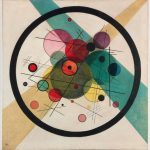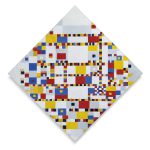Abstrakte Kunst wird oftmals als nicht-darstellende Kunst bezeichnet. Das liegt daran, dass sie nicht der damaligen Meinung, dass Kunst die reale Welt der Menschen (und anderer Geschöpfe), Orte und Dinge darstellen müsse, entspricht. Jedoch begannen Künstler und Künstlerinnen ab dem frühen 20. Jahrhundert Dinge so darzustellen, dass sie nicht leicht erkennbar, sprich abstrakt waren. Die Gemälde dieser Einheit sind Beispiele für solch eine abstrakte Kunst. Nachdem Sie die Bilder angesehen und diskutiert haben, werden in der Philosophie-Einheit Fragen darüber aufgeworfen, was es heißt, wenn etwas abstrakt ist.
Start: Erkundung der abstrakten Kunst →
Wählen Sie ein Werk von unten aus, um dort weiterzumachen, wo Sie aufgehört haben.


